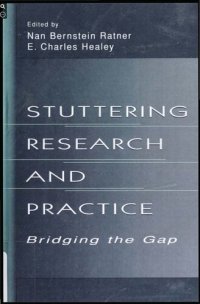
Ebook: Stuttering: A Unified Approach to a Multifactorial, Dynamic Disorder
Author: Anne Smith
- Genre: Medicine // Therapy
- Tags: stuttering speech pathology
- Series: Stuttering Research and Practice: Bridging the Gap
- Year: 1999
- Publisher: Psychology Press
- Edition: 1
- Language: English
- pdf
Chapter 3 from the book "Stuttering Research and Practice: Bridging the Gap"
(Highly cited description of popular theoretical approach to understanding stuttering.)
ABSTRACT
The goal of this chapter is to propose a global, unified strategy that will aid our attempts to understand and to treat stuttering. I do not suggest that all of us will agree about all aspects of stuttering; we will not. What I propose is that, if we could agree on some of the broader issues that drive research and treatment, progress would be more rapid. Furthermore, a widely shared, comprehensive approach to stuttering would provide a critically needed foundation for communicating about the disorder. A shared framework would improve communication among researchers and clinicians, and in turn, communication with individuals who stutter, with parents, with teachers, and with society at large. The myriad approaches to stuttering research and treatment have created a fragmented and confusing literature on the disorder. Papers traditionally were written as if the “answer” to stuttering could be discovered within whatever clinical or experimental approach a particular group believed at a particular time. Those of us who have been in the field for some time have witnessed the recycling of old “answers,” for example, the current reemergence of DAF and feedback theories of stuttering (e.g., Harrington, 1988). However, there has been growing agreement among many researchers and clinicians that stuttering is a multifactorial disorder (Conture, 1990; Riley & Riley, 1979; Smith, 1990a; Smith & Kelly, 1997; Starkweather, Gottwald, & Halfond, 1990; Van Riper, 1982; Wall & Myers, 1995; Zimmermann, 1980; Zimmermann, Smith,&Hanley, 1981). The present chapter explores the possible ways in which a multifactorial and dynamic model of stuttering can accelerate and expand progress in our field.
(Highly cited description of popular theoretical approach to understanding stuttering.)
ABSTRACT
The goal of this chapter is to propose a global, unified strategy that will aid our attempts to understand and to treat stuttering. I do not suggest that all of us will agree about all aspects of stuttering; we will not. What I propose is that, if we could agree on some of the broader issues that drive research and treatment, progress would be more rapid. Furthermore, a widely shared, comprehensive approach to stuttering would provide a critically needed foundation for communicating about the disorder. A shared framework would improve communication among researchers and clinicians, and in turn, communication with individuals who stutter, with parents, with teachers, and with society at large. The myriad approaches to stuttering research and treatment have created a fragmented and confusing literature on the disorder. Papers traditionally were written as if the “answer” to stuttering could be discovered within whatever clinical or experimental approach a particular group believed at a particular time. Those of us who have been in the field for some time have witnessed the recycling of old “answers,” for example, the current reemergence of DAF and feedback theories of stuttering (e.g., Harrington, 1988). However, there has been growing agreement among many researchers and clinicians that stuttering is a multifactorial disorder (Conture, 1990; Riley & Riley, 1979; Smith, 1990a; Smith & Kelly, 1997; Starkweather, Gottwald, & Halfond, 1990; Van Riper, 1982; Wall & Myers, 1995; Zimmermann, 1980; Zimmermann, Smith,&Hanley, 1981). The present chapter explores the possible ways in which a multifactorial and dynamic model of stuttering can accelerate and expand progress in our field.
Download the book Stuttering: A Unified Approach to a Multifactorial, Dynamic Disorder for free or read online
Continue reading on any device:

Last viewed books
Related books
{related-news}
Comments (0)